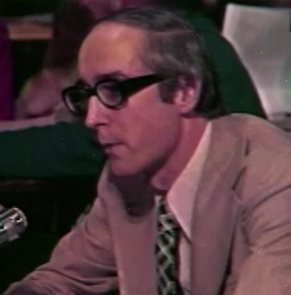Tom Charles Huston
(lawyer) | |
|---|---|
 | |
| Born | 9 March, 1941 |
| Alma mater | Indiana University |
Wrote The Huston Plan, a COINTELPRO-similar scheme, for Nixon. Left to fall by the FBI during Watergate. | |
'Tom Charles Huston was a White House aide to President Richard Nixon. He wrote what became known as The Huston Plan, a 43-page report and outline of proposed security operations.
Dabbling in intelligence work on behalf of the president, he was disliked by the FBI and CIA leadership. (deep throat Mark Felt mocked Huston as “the White House gauleiter” (a regional Nazi leader); J. Edgar Hoover called him a “hippie intellectual” who’d humiliated him.[1] The plan came to light during the 1973 Watergate hearings.
"Of all of Richard Nixon’s men, Tom Charles Huston remains the most elusive. The lanky, bespectacled ideologue from Logansport, Indiana entered politics at an early age. At age 24, he chaired America’s largest conservative organization; at age 28, he became Nixon’s speechwriter. Just a year later, he drafted a wide-ranging domestic intelligence program, officially discarded only to be adopted piecemeal, forming the blueprint for Watergate."[1]
Backed by conservative businessmen, Huston founded the World Youth Crusade for Freedom. Huston described this as “the first step towards molding together a permanent anti-Communist international apparatus.” Its instrument was the Freedom Corps, their equivalent to the Peace Corps, sending conservative youth abroad for recruitment and networking. Facing hostility and indifference (most of its members visited Taiwan and returned home, with only a handful reaching Vietnam), the Corps folded by 1968.[1]
Undeterred, Huston attended several anticommunist conferences in Asia and visited South Vietnam. There, he met with American soldiers, Vietnamese officials and Taiwanese anticommunists who assured him that “the Vietnamese people…fear [Communism] and are prepared to fight to the death against it.”[1]
He was associate Counsel to the President Richard Nixon 1969-1971.[2]
After a grilling by the Church Committee in 1975, Huston retired to a lucrative law practice in Indianapolis, Barnes and Thorburg.
The Huston Plan
The Huston Plan was a 43-page report and outline of proposed security operations put together by White House aide Tom Charles Huston in 1970.[3] It came to light during the 1973 Watergate hearings headed by Senator Sam Ervin (a Democrat from North Carolina).
The impetus for this report was President Richard Nixon's desire for coordination of domestic intelligence on purported 'left-wing radicals' and the counterculture-era anti-war movement in general. Huston had been assigned as White House liaison to the Interagency Committee on Intelligence (ICI), a group chaired by J. Edgar Hoover, then Federal Bureau of Investigation (FBI) Director. Huston worked closely with William C. Sullivan, Hoover's assistant, in drawing up the options listed in what eventually became the document known as the Huston Plan.
The plan called for domestic burglary, illegal electronic surveillance and opening the mail of domestic "radicals". At one time it also called for the creation of camps in Western states where anti-war protesters would be detained.
In mid-July 1970 Nixon ratified the proposals and they were submitted as a document to the directors of the FBI, Central Intelligence Agency (CIA), Defense Intelligence Agency (DIA) and the National Security Agency (NSA).
Only Hoover objected to the plan (he already had the virtually identical COINTELPRO program, and was suspicious of getting blamed if the new scheme became known, and gained the support of then Attorney General of the United States John Mitchell to pressure Nixon to rescind the plan.[4] Despite the ultimate decision by the President to revoke the Huston Plan, several of its provisions were implemented.
After the Huston Plan, the FBI lowered the age of campus informants, thereby expanding surveillance of American college students as sought through the Plan. In 1971, the FBI reinstated its use of mail covers and continued to submit names to the CIA mail program.
As details of the Huston Plan unfolded during the Watergate Hearings, it came to be seen as part of what Attorney General Mitchell referred to as "White House horrors". This included the Plumbers Unit, the proposed fire-bombing of the Brookings Institution, the 1971 burglary of the office of the psychiatrist of Daniel Ellsberg, the creation of a White House enemies list, and the use of the Internal Revenue Service (IRS) to punish those deemed to be enemies.
The Huston Plan was also investigated by the U.S. Senate Select Committee on Intelligence, chaired by Senator Frank Church in 1976, into activities of the CIA and abuses of domestic intelligence gathering.
References
- ↑ a b c d https://the-avocado.org/2019/06/08/how-we-got-here-the-education-of-tom-charles-huston/
- ↑ https://webcache.googleusercontent.com/search?q=cache:KwxVrC4qaK8J:https://prabook.com/web/tom_charles.charles_huston/1353904+&cd=16&hl=en&ct=clnk&gl=au&client=firefox-b-d
- ↑ https://web.archive.org/web/20090220091431/http://us.history.wisc.edu/hist102/lectures/lecture30.html
- ↑ White, Theodore H. (1975). Breach of faith; the fall of Richard Nixon. Dell. p. 135.
External links
- Huston Plan: Hearings before the Select Committee to Study Governmental Operations with Respect to Intelligence Activities, Church Committee, U.S. Senate, Sept. 23-25, 1975.
- SUPPLEMENTARY DETAILED STAFF REPORTS ON INTELLIGENCE ACTIVITIES AND THE RIGHTS OF AMERICANS, published by the Senate Select Committee on Intelligence
- Interview with Army whistleblower Chris Pyle, American Public Media